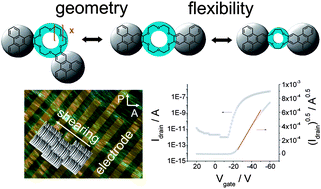Design of conductive crown ether based columnar liquid crystals: impact of molecular flexibility and geometry†
Abstract
The influence of the molecular shape on the charge transport in the columnar mesophases of bi-centred

* Corresponding authors
a
Institute of Physical Chemistry, University of Stuttgart, Pfaffendwaldring 55, 70569 Stuttgart, Germany
E-mail:
f.giesselmann@ipc.uni-stuttgart.de
Tel: +49-685-64460
b Institute of Organic Chemistry, University of Stuttgart, Pfaffendwaldring 55, 70569 Stuttgart, Germany
c Institute of Polymer Chemistry, University of Stuttgart, Pfaffendwaldring 55, 70569 Stuttgart, Germany
The influence of the molecular shape on the charge transport in the columnar mesophases of bi-centred

 Please wait while we load your content...
Something went wrong. Try again?
Please wait while we load your content...
Something went wrong. Try again?
P. Staffeld, M. Kaller, S. J. Beardsworth, K. Tremel, S. Ludwigs, S. Laschat and F. Giesselmann, J. Mater. Chem. C, 2013, 1, 892 DOI: 10.1039/C2TC00284A
To request permission to reproduce material from this article, please go to the Copyright Clearance Center request page.
If you are an author contributing to an RSC publication, you do not need to request permission provided correct acknowledgement is given.
If you are the author of this article, you do not need to request permission to reproduce figures and diagrams provided correct acknowledgement is given. If you want to reproduce the whole article in a third-party publication (excluding your thesis/dissertation for which permission is not required) please go to the Copyright Clearance Center request page.
Read more about how to correctly acknowledge RSC content.
 Fetching data from CrossRef.
Fetching data from CrossRef.
This may take some time to load.
Loading related content
